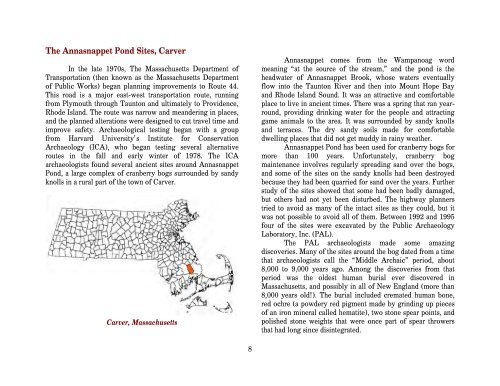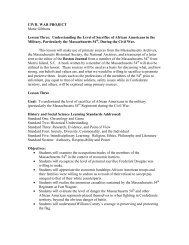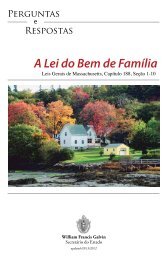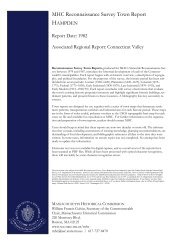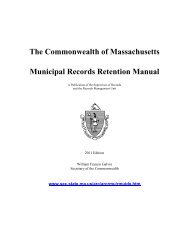Roads, Rails, and Trails - Secretary of the Commonwealth
Roads, Rails, and Trails - Secretary of the Commonwealth
Roads, Rails, and Trails - Secretary of the Commonwealth
You also want an ePaper? Increase the reach of your titles
YUMPU automatically turns print PDFs into web optimized ePapers that Google loves.
The Annasnappet Pond Sites, Carver<br />
In <strong>the</strong> late 1970s, The Massachusetts Department <strong>of</strong><br />
Transportation (<strong>the</strong>n known as <strong>the</strong> Massachusetts Department<br />
<strong>of</strong> Public Works) began planning improvements to Route 44.<br />
This road is a major east-west transportation route, running<br />
from Plymouth through Taunton <strong>and</strong> ultimately to Providence,<br />
Rhode Isl<strong>and</strong>. The route was narrow <strong>and</strong> me<strong>and</strong>ering in places,<br />
<strong>and</strong> <strong>the</strong> planned alterations were designed to cut travel time <strong>and</strong><br />
improve safety. Archaeological testing began with a group<br />
from Harvard University’s Institute for Conservation<br />
Archaeology (ICA), who began testing several alternative<br />
routes in <strong>the</strong> fall <strong>and</strong> early winter <strong>of</strong> 1978. The ICA<br />
archaeologists found several ancient sites around Annasnappet<br />
Pond, a large complex <strong>of</strong> cranberry bogs surrounded by s<strong>and</strong>y<br />
knolls in a rural part <strong>of</strong> <strong>the</strong> town <strong>of</strong> Carver.<br />
Carver, Massachusetts<br />
8<br />
Annasnappet comes from <strong>the</strong> Wampanoag word<br />
meaning “at <strong>the</strong> source <strong>of</strong> <strong>the</strong> stream,” <strong>and</strong> <strong>the</strong> pond is <strong>the</strong><br />
headwater <strong>of</strong> Annasnappet Brook, whose waters eventually<br />
flow into <strong>the</strong> Taunton River <strong>and</strong> <strong>the</strong>n into Mount Hope Bay<br />
<strong>and</strong> Rhode Isl<strong>and</strong> Sound. It was an attractive <strong>and</strong> comfortable<br />
place to live in ancient times. There was a spring that ran yearround,<br />
providing drinking water for <strong>the</strong> people <strong>and</strong> attracting<br />
game animals to <strong>the</strong> area. It was surrounded by s<strong>and</strong>y knolls<br />
<strong>and</strong> terraces. The dry s<strong>and</strong>y soils made for comfortable<br />
dwelling places that did not get muddy in rainy wea<strong>the</strong>r.<br />
Annasnappet Pond has been used for cranberry bogs for<br />
more than 100 years. Unfortunately, cranberry bog<br />
maintenance involves regularly spreading s<strong>and</strong> over <strong>the</strong> bogs,<br />
<strong>and</strong> some <strong>of</strong> <strong>the</strong> sites on <strong>the</strong> s<strong>and</strong>y knolls had been destroyed<br />
because <strong>the</strong>y had been quarried for s<strong>and</strong> over <strong>the</strong> years. Fur<strong>the</strong>r<br />
study <strong>of</strong> <strong>the</strong> sites showed that some had been badly damaged,<br />
but o<strong>the</strong>rs had not yet been disturbed. The highway planners<br />
tried to avoid as many <strong>of</strong> <strong>the</strong> intact sites as <strong>the</strong>y could, but it<br />
was not possible to avoid all <strong>of</strong> <strong>the</strong>m. Between 1992 <strong>and</strong> 1995<br />
four <strong>of</strong> <strong>the</strong> sites were excavated by <strong>the</strong> Public Archaeology<br />
Laboratory, Inc. (PAL).<br />
The PAL archaeologists made some amazing<br />
discoveries. Many <strong>of</strong> <strong>the</strong> sites around <strong>the</strong> bog dated from a time<br />
that archaeologists call <strong>the</strong> “Middle Archaic” period, about<br />
8,000 to 9,000 years ago. Among <strong>the</strong> discoveries from that<br />
period was <strong>the</strong> oldest human burial ever discovered in<br />
Massachusetts, <strong>and</strong> possibly in all <strong>of</strong> New Engl<strong>and</strong> (more than<br />
8,000 years old!). The burial included cremated human bone,<br />
red ochre (a powdery red pigment made by grinding up pieces<br />
<strong>of</strong> an iron mineral called hematite), two stone spear points, <strong>and</strong><br />
polished stone weights that were once part <strong>of</strong> spear throwers<br />
that had long since disintegrated.


